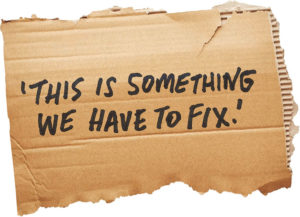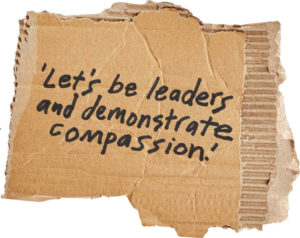Ken Budd

A homeless man was following a member of Windy Christner’s team. He wanted cash. Christner, CMP, senior director, meetings and expositions with the American Pharmacists Association (APhA), was with colleagues in April, during a site visit to the Washington State Convention Center in downtown Seattle. On their short trek from the hotel to the convention center, they also saw three people who appeared to be taking drugs. Another person had passed out. The smell of marijuana and stale urine soured the air outside of the convention center.
Seattle is one of APhA’s top picks as a convention destination and its March 2019 event will pump $8.5 million into the city’s economy, by APhA’s estimate. “I feel at home there,” Christner said. “The people are genuine and warm and the city has a diverse mix of neighborhoods and beautiful scenery. It’s youthful and vibrant — I feel hip when I’m there.” But after that disturbing site visit, APhA shared its concerns with Visit Seattle, and asked for additional security. “We may need to remove Seattle from future consideration,” the APhA team wrote.
It’s not that Visit Seattle hasn’t acted to address the homelessness crisis. Since 2008, Visit Seattle has maintained a Street Scene Task Force that participates in public policy, supports strong policing, and advocates for sustainable, long-term solutions to homelessness, public safety, and civility. The Seattle Hotel Association has raised more than $2 million for Mary’s Place, which offers emergency night shelter and daycare services for homeless families with children. And in May, when the city council approved a $1.6-billion expansion of the convention center, the plan included $39 million for affordable housing. “We have a long history of addressing this issue with city leaders, early customer advisory board members, and customers,” said Tom Norwalk, president and CEO of Visit Seattle. “It’s important to us to address Seattle’s street scene with our meeting planners not only for transparency, but to be able to address any concerns well before groups arrive.”
And, as Christner notes, homelessness is not simply a Seattle problem, although it’s a particularly American one. “I have seen similar increases [in homeless populations] in several other convention destinations,” she said. On a given night, approximately 554,000 people in the United States are homeless, the U.S. Department of Housing and Urban Development (HUD) reported in December 2017, the largest total since 2010. And HUD’s methodology undercounts the number of homeless, many organizations say: The National Law Center on Homelessness & Poverty (NLCHP) has estimated that 2.5-3.5 million people are homeless in the U.S. over the course of a year. Los Angeles’s homeless population rose by 20 percent between 2016 and 2017, according to the Urban Land Institute. In New York City, the number of homeless and unsheltered people increased by 39 percent in 2017, the city government found, the highest increase since 2005.
The problems are not only raising concerns among meeting professionals, they are affecting how they do business. In an August 2018 survey conducted by Convene, 42 percent of respondents said they had rejected a meeting site because of homelessness, and 72 percent said that meeting attendees have expressed discomfort about certain destinations because of the issue. Sixty-seven percent said that they routinely ask about homelessness as part of their site visits and 38 percent have taken actions to address potential safety issues, such as hiring extra security.
Seeing so many homeless people has led to personal and professional soul-searching for several survey respondents. “It sometimes makes me question my career path,” one wrote. “Wrapping up a 500-person dinner inside the hotel, especially those with lots of excess leftovers, and then walking outside and seeing people who may not have eaten all day? I have trouble reconciling that emotionally.”
Perception, Reality, and Rising Homelessness<
Many respondents to Convene’s survey expressed empathy for homeless individuals — even as they registered their concerns. And while homeless people are more likely to be victims of violent crime than to commit them, the safety concerns of meeting planners are valid. In San Diego, a meeting planner was attacked by a homeless person in a hotel bar in 2017, The San Diego Union-Tribune reported. “We’re not the least expensive city, but we have a great product and have always been a safe and secure and clean environment,” San Diego Tourism Authority CEO Joe Terzi told the Union-Tribune. “But if we lose that, we could lose our competitive advantage. We feel [homelessness] is the No. 1 issue we have to deal with now.”
In Denver, a Convene survey respondent refused to give a homeless man money, which led to a confrontation: “[He] said some choice words and pointed his finger at me like a gun and said, ‘I just want to shoot all the tourists.’” One respondent shared that two meeting attendees in their group were attacked while walking to the convention center in Los Angeles. A manager with a meeting services firm in Boston (who asked to remain anonymous) said that one of his speakers was assaulted on a BART train in San Francisco. “We have been inundated with survey responses from attendees who feel unsafe in the city.” Meeting attendees’ basic needs for comfort, safety, and security are an essential part of providing a positive event experience, wrote a respondent to Convene’s survey. “Without reassurance that the local governing bodies are willing to assist the homeless and keep the city clean, we look to other destinations.”
“At a time when we are focused upon designing experiences,” asked another respondent, “why in the world would we design one in a location where attendees encounter drugs, human waste, or the fear of being mugged?” Paradoxically, homelessness is growing in cities that, like San Francisco, have some of the strongest economies in the nation. And despite its large homeless population, San Francisco is America’s safest city, and the 15th safest city in the world, according to The Economist magazine’s 2017 Safe Cities Index.
How can a city experience rising homelessness while thriving economically? Many of the reasons for homelessness are well known — unemployment, poverty, mental illness, substance abuse, a lack of affordable health care — but the chief cause is a lack of affordable housing, according to a survey by the U.S. Conference of Mayors. San Francisco is a good example: Although the unemployment rate in the city is very low, the cost of housing is among the highest in the world. The median annual income for homebuyers is $303,000.
Cuts in federal funding for services are also causing pain. Safe Haven, a homeless shelter in Madison, Wisconsin, recently reported the loss of $350,000 in federal grants. Instead of being open 24 hours a day, the shelter now stays open for 11 hours. President Donald Trump’s 2019 budget called for cutting basic assistance that helps millions of families pay for food, rent, and health care, the nonpartisan Center on Budget and Policy Priorities reports.

John McNichol
The opioid epidemic has also taken a toll. “All major cities and many suburban communities are experiencing a spike in homelessness due in large part to the opioid crisis,” John McNichol, president and CEO of the Pennsylvania Convention Center, told Convene. Homeless populations “have higher rates of substance-use disorders, poorer health, and higher mortality rates by opioid overdose than national averages,” the National Health Care for the Homeless Council notes. “Addiction can cause and prolong homelessness, and the experience of homelessness complicates one’s ability to engage in treatment.”
Working on Solutions

Joe Demille
On a site visit to Austin, Texas, Joe DeMille ate breakfast in the lobby of a downtown hotel. He was there with the volunteer-managed Society for Collegiate Travel & Expense Management (SCTEM), which was considering the hotel for its September 2018 conference. DeMille, who had encountered numerous homeless people while walking downtown, was sharing his concerns with the hotel’s sales rep. Moments after DeMille raised the topic, a homeless person interrupted their breakfast to ask for money. SCTEM decided to host its conference in Austin’s suburbs rather than downtown.
“From a travel manager’s perspective, your No. 1 priority is your duty of care,” DeMille, vice president of business development for EDU Hospitality Consultants, told Convene. “Eighty percent of our attendees are female. Austin is a great city, but we needed an environment where I would feel comfortable that people were safe. The business community needs to be aware that they’re going to lose business in if they don’t figure out a solution to the problem.”
 Cities like Austin are definitely aware. In April, the Austin City Council passed the Action Plan to End Homelessness, developed by the city and the nonprofit Ending Community Homelessness Coalition. The goal: To provide more services and shelter, and to improve the city’s response system. And in May, Joe D’Alessandro, president and CEO of San Francisco Travel, appeared on a local public radio station to raise the alarm about the effect of homelessness, open drug use, and street crime on the city’s $10-billion tourism industry, including business events.
Cities like Austin are definitely aware. In April, the Austin City Council passed the Action Plan to End Homelessness, developed by the city and the nonprofit Ending Community Homelessness Coalition. The goal: To provide more services and shelter, and to improve the city’s response system. And in May, Joe D’Alessandro, president and CEO of San Francisco Travel, appeared on a local public radio station to raise the alarm about the effect of homelessness, open drug use, and street crime on the city’s $10-billion tourism industry, including business events.

Joe D’Alessadro
“We see very dark clouds on the horizon,” D’Alessandro told KQED Public Radio’s Michael Krasny. “We see a number of large convention groups saying, ‘We love San Francisco, we’ve been coming here for a long time, but our delegates are getting harassed or getting their phones stolen while they are walking down the street or are worried about stepping on needles and human excrement.’” In 2017, the number of convention visitors to San Francisco was down, he said. “This is something we have to fix.”
The city’s public and private sectors are working hard to address the meeting industry’s concerns. San Francisco Travel has a director of safety and security who deploys street patrols during major conferences and events. In late 2017, the city launched the Healthy Street Operation Center to better coordinate responses to behavior issues. The city has also created Navigation Centers that shelter vulnerable and long-term homeless residents, and connect them to income, public benefits, and health services, and is investing $60 million in new funding for homelessness service programs over the next two years. It’s a difficult problem, D’Alessandro told the radio audience in May, but many places around the world have found humane solutions. “We have to get to the root of the problem,” he said. “You don’t see this kind of situation in Europe. You don’t see it in Asia. You don’t see it in a lot of places, and I think it’s going to take the combination of political leadership, citizen activism, and activism on the part of the business community [to solve it].”
The city of Philadelphia, which has experienced homeless crowds near its convention center, has received kudos from homeless advocates for its efforts. The city invests $45 million a year to reduce its homeless population and offers nearly 12,000 emergency and permanent beds. Between 2016 and 2017, 465 people who had a history of street homelessness were placed into permanent housing. Ninety-two percent avoided a return to homelessness. The city also worked with local groups to open the Hub of Hope, an 11,000-square-foot center offering meals, showers, laundry, medical and behavioral health, and legal services for homeless individuals. “Engagement centers have a major impact on reducing street homelessness,” Pennsylvania Convention Center’s McNichol said. “More importantly, they build bridges to treatment, shelter, and services for individuals who are otherwise reluctant to come in off the streets.”
Cities often relocate homeless people when hosting big events like the Super Bowl. When the City of Brotherly Love hosted the Democratic convention in 2016, Philly increased its outreach efforts and created 110 new beds for homeless people. “Many cities are concerned about visible homelessness around their convention centers and hotel districts, and use that as an excuse to criminalize homelessness, or even to sweep encampments from their streets,” said Eric S. Tars, senior attorney for the National Law Center Homelessness & Poverty. Thirty-two percent of cities prohibit loitering, loafing, and vagrancy — ordinances that “grant police a broad tool for excluding visibly poor and homeless people from public places,” according to a 2016 Law Center report. But, “the best way to ensure homeless people don’t detract from convention comfort is to ensure that they aren’t on the streets in the first place,” Tars said.
“Lots of research shows that housing people is more effective and more cost-effective. When homeless people are housed it’s a win for them, a win for the businesses supported by conventions, and a win for the city’s image. Trying to push them out of public view through criminalization costs taxpayers more, gives homeless people criminal records and fines that make it harder to exit homelessness, and ultimately does nothing to solve the problem.”
Over the last decade, more than 300 cities have adopted a “Housing First” strategy, which seeks to find secure housing for the chronically homeless, rather than focusing on behavior or addiction problems. (See “How Milwaukee Puts Housing First.”)
Another Kind of Impact

Donna Jarvis-Miller, CMP
“I am never going to put my members in a city where they are in danger, and I think that that is true of any planner,” said Donna Jarvis-Miller, CMP, CEM, director of membership and events at the American Public Human Services Association (APHSA). “The safety of our members is at the forefront.” But that doesn’t mean that Jarvis-Miller avoids destinations where homelessness is an issue — she works with them in advance to understand where problems exist and how to circumvent them, she said. Given that homelessness is a concern in so many cities, as an industry we can “help our members understand how they can make an impact on the communities” where they meet, she said.
Her group is perhaps biased toward action — many APHSA members, who work at senior levels at health and human services agencies, already are focused on finding solutions to problems including homelessness, she said. But the issue presents an opportunity for many more associations and organizations to educate their members, Jarvis-Miller said. “We need to embrace these issues and not bury our heads in the sand. We go about our lives — those of us fortunate enough to have a job and a house and food on our tables — and we pass people on the street, or who are sitting at intersections, and we don’t necessarily think about how we can help,” she said. “We don’t understand that every [homeless person] has a story.”
Jarvis-Miller is among the 35 percent of survey respondents who have organized CSR activities to address homelessness. (See “4 Ways Meetings Help Homeless Communities.”) “When APHSA met in Seattle in September for 2018 ISM Conference, which focuses on health and human services and information technology, attendees donated supplies via an online registry to the Compass Housing Alliance, an organization providing food, temporary shelter, and permanent housing in Seattle. Jarvis-Miller also gave members an opportunity to make more personal contact. A smaller group — attendance was capped at 45 — cooked for residents at the shelter and then sat down to share a meal and conversation. The in-person event, which took place a day before the conference started and also raised money for the shelter, was sold out two weeks after registration opened, Jarvis-Miller said.
“Conventions threatening to cancel just encourages cities to sweep the problem under the rug, and that’s not a responsible solution,” said Marc Morial, president of the National Urban League. “We encourage conferences and conventions to help cities tackle the problem rather than cover it up.”
The Human Side of Homelessness
 When we see the homeless, most of us avert our eyes. Not Ami Angell. As street outreach manager for the nonprofit HER Resiliency Center, Angell assists vulnerable young women on the streets of Washington, D.C. In the winter, she and her colleagues provide blankets. In the summer, they hand out water bottles. Their mission: to persuade young women to leave the streets. Angell has devoted her career to fighting human trafficking. “I’ve encountered many people, especially those who have been trafficked, who’ve told me, ‘I was just waiting for someone to ask me how I was. That’s all I wanted.’ Sometimes all it takes is the small things. A smile. Saying, ‘Hey — how are you?’ It’s not necessarily about giving money. In some ways, that’s just enabling. One of my friends makes bags of homemade cookies. When I go on the streets and hand those out, people’s faces light up.”
When we see the homeless, most of us avert our eyes. Not Ami Angell. As street outreach manager for the nonprofit HER Resiliency Center, Angell assists vulnerable young women on the streets of Washington, D.C. In the winter, she and her colleagues provide blankets. In the summer, they hand out water bottles. Their mission: to persuade young women to leave the streets. Angell has devoted her career to fighting human trafficking. “I’ve encountered many people, especially those who have been trafficked, who’ve told me, ‘I was just waiting for someone to ask me how I was. That’s all I wanted.’ Sometimes all it takes is the small things. A smile. Saying, ‘Hey — how are you?’ It’s not necessarily about giving money. In some ways, that’s just enabling. One of my friends makes bags of homemade cookies. When I go on the streets and hand those out, people’s faces light up.”
Malak Sidky, the CEO and founder of Health Care Event Planning in Toronto, makes similar connections between human trafficking and homelessness. Sidky is active in Meeting Professionals Against Human Trafficking (MPAHT), an organization founded last year in Toronto to create awareness in the events industry about human trafficking. “Traffickers go out of their way to go to where homeless people congregate and that’s where they’re picked up,” Sidky said. The homeless “are a vulnerable population already, because they don’t have social support. These are the very people we are trying to support.”

Malak Sidky
Sidky, who has a master’s degree in health administration, has worked with homeless individuals at a community health center. Given her background, she knows how easily job loss, domestic abuse, illness, and other events can lead to the loss of housing, and she questioned the implication homeless people could be seen primarily as security problem. Homelessness “can happen to anyone,” she said. Like other survey respondents, she wondered how the industry could tolerate so much food and other waste at events when others are hungry and lack basic shelter. “Let’s be leaders in this industry,” Sidky said, “and demonstrate compassion.” In Philadelphia, convention center clients may express concerns related to homelessness, McNichol said, but they appreciate the city’s emphasis on dignity and empathy. “Homeless individuals are people,” he said. “They are mothers, fathers, sons, and daughters in need. Our customers understand this.”
Christner is well into the planning process for bringing APhA to the Emerald City in 2019. “We anticipate a resounding success in this wonderful destination,” she says. Christner will work with the CVB and hotel partners to ensure attendee safety, and APhA will also provide links so attendees can donate to local food banks and shelters. At previous conventions, APhA has worked with Paws for Veterans, a national organization providing service dogs to vets with PTSD. After their recent experience in Seattle, they’re switching their focus to homelessness. “Pharmacists contribute to the well being and positive quality of life for their patients on a daily basis,” Christner said. At APhA 2019, “our goal is to play a part in helping the community as best we can.”
Read our story about “Hacking Homelessness” about an event professional who organized a hackathon to respond to homelessness in Glasgow, and “What Convention Centers Are Doing to Respond to Homelessness.”
Test Time
Earn one clock hour of certification credit by reading this story and sidebars, and reading the article, “What I Learned By Organizing My First Hackathon.”
To earn certification clock hours, visit pcma.org/convene-cmp-series to answer questions about information contained in this CMP Series article and the additional material.
The Certified Meeting Professional (CMP) is a registered trademark of the Events Industry Council.

